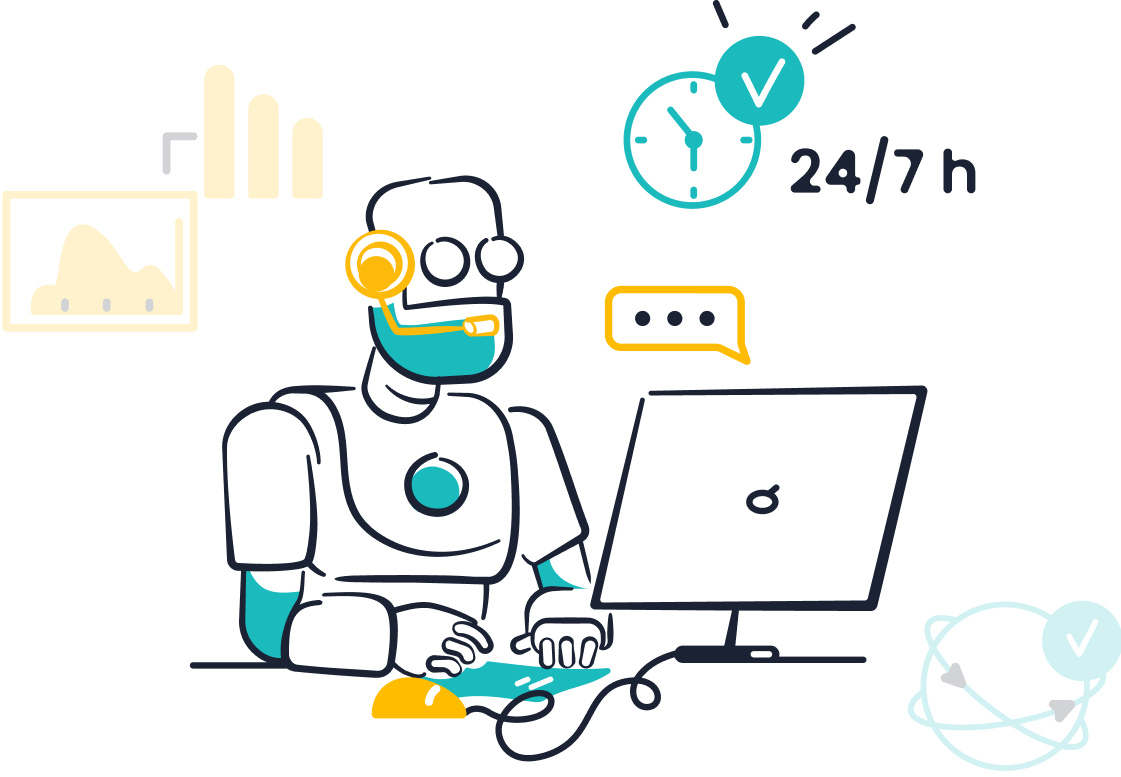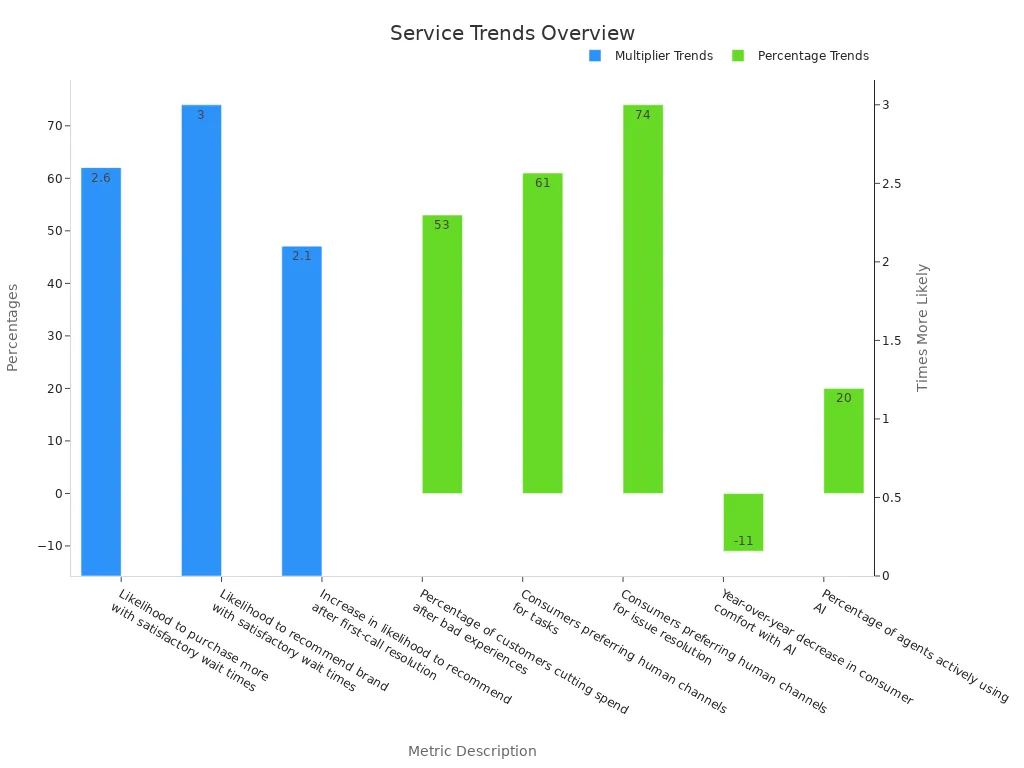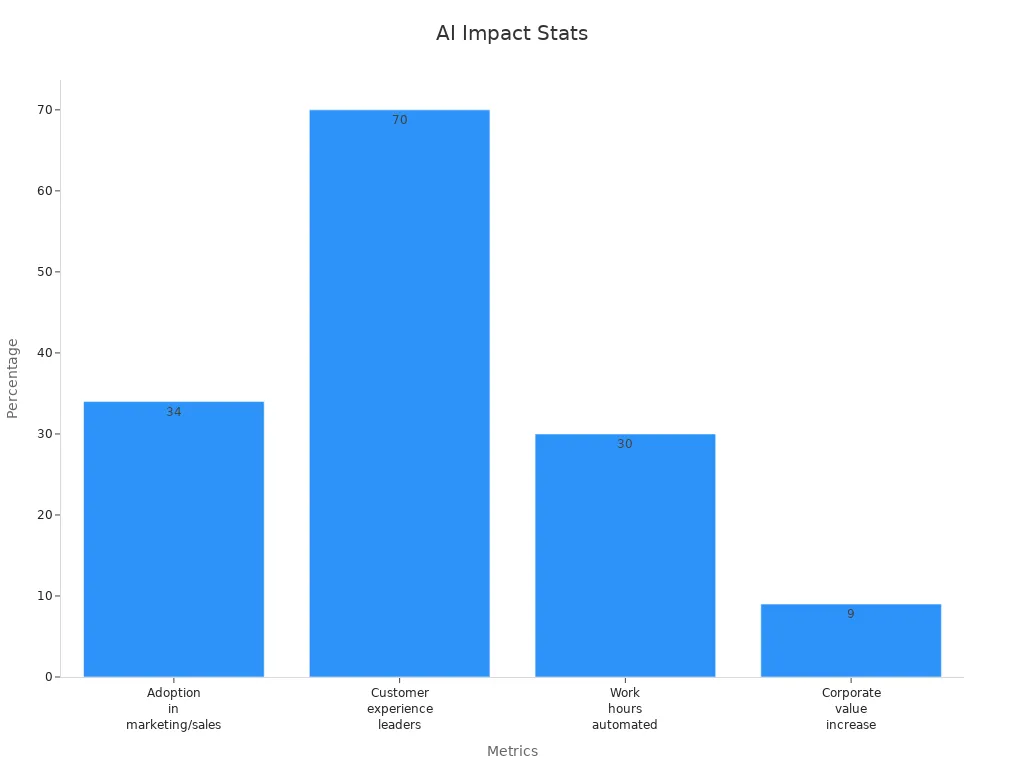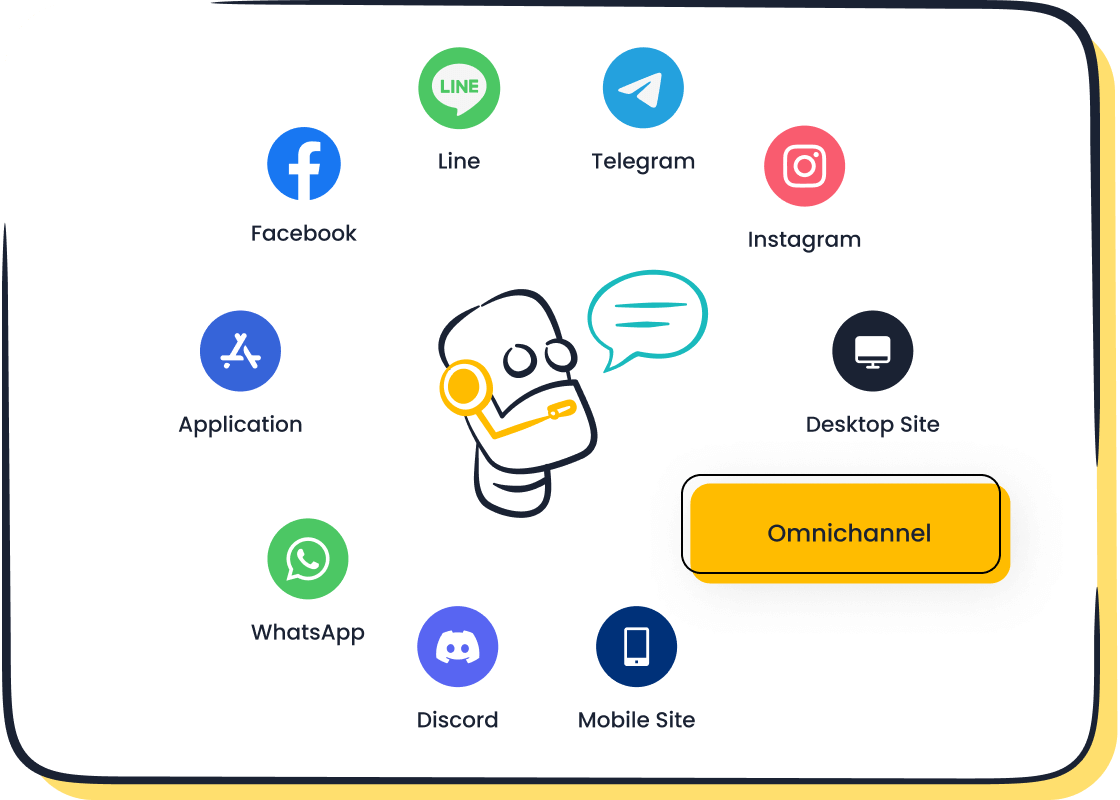Don’t Miss These Fresh Service Strategy Updates

Service strategy is transforming at record speed in 2025. Customer expectations keep rising, and 71% of customers now demand personalized experiences. Businesses that ignore these shifts risk falling behind as 53% of customers cut spending after negative service. AI, omnichannel support, and proactive service drive this change. Sobot leads this innovation with Sobot AI, offering seamless solutions that meet the needs of modern customer service. Companies see higher loyalty and revenue growth by focusing on strategies that deliver fast, accurate responses across every channel.

2025 Service Strategy Trends
The service strategy landscape in 2025 continues to evolve rapidly. Businesses must adapt to new customer service trends to stay competitive. Three major trends define this shift: AI-driven personalization, omnichannel integration, and proactive self-service. Companies like Sobot lead the way by offering solutions that align with these trends, helping brands deliver seamless, efficient, and personalized experiences.
AI Personalization
AI personalization stands at the center of modern service strategy in 2025. Companies use AI to analyze customer data and deliver tailored interactions. Over 50% of email marketers now identify content personalization as their top AI use case. More than half of marketers use AI to optimize content on websites and social media, focusing on customer segmentation and engagement. These data-driven strategies help brands understand customer needs and provide personalized experiences at every touchpoint.
Sobot’s AI-powered chatbot uses advanced algorithms to automate responses and personalize conversations. The chatbot supports multiple languages and channels, ensuring customers receive relevant information quickly. By leveraging AI, Sobot helps businesses boost productivity, cut costs, and increase conversion rates. This approach transforms customer service into a proactive, data-driven process.
Omnichannel Support
Omnichannel support has become essential for delivering a unified customer experience in 2025. Customers expect to interact with brands across chat, social media, phone, and email without repeating themselves. Omnichannel strategies ensure seamless, connected experiences and reinforce brand commitment.
- Omnichannel integration prevents customers from repeating information across channels.
- Consistency across platforms builds trust and loyalty.
- AI-driven chatbots handle simple inquiries, while human agents address complex issues.
- Integrated tools reduce silos and improve collaboration.
- These approaches lower ticket resolution times and boost productivity.
| Evidence Aspect | Details |
|---|---|
| Customer Expectations | 72% demand immediate service; 80% prefer personalized experiences; 62% expect fast social media responses. |
| Business Impact Metrics | 10% increase in customer lifetime value; 10-15% revenue growth; 85% CSAT for omnichannel companies. |
| Real-World Example | IKEA’s unified online and offline channels drive sales and loyalty. |
| Technology Enablers | AI-powered chatbots, unified data platforms, and integration tools enable seamless engagement. |
| Organizational Factors | Cross-functional teams and continuous training sustain omnichannel success. |
Sobot’s omnichannel solutions unify customer data and interactions in one workspace. The platform integrates chat, voice, email, and social media, allowing agents to access all customer information instantly. This unified approach supports fast, accurate service and strengthens customer relationships.
Proactive Self-Service
Proactive self-service is a defining trend in 2025 service strategy. AI-powered platforms enable customers to resolve issues quickly, freeing agents to focus on complex needs. Brice Mesquida from ServiceNow highlights that proactive self-service aligns technology investments with customer expectations and business goals.
Organizations see measurable improvements with proactive customer service:
| Measurable Outcome | Metric / Statistic |
|---|---|
| Operational Efficiency Increase | 20-30% improvement |
| Customer Satisfaction Score Boost | 10-15% increase |
| Reduction in Avoidable Support Calls | 25-40% decrease |
| Customer Desire for Proactive Contact | 87% want proactive contact |
| Positive Brand Perception from Contact | 73% report improved brand perception |
Forrester reports that automation and AI-driven proactive service management reduce ticket volumes and improve productivity. Sobot’s AI chatbot offers 24/7 self-service, automating routine queries and providing instant answers. This proactive approach not only improves operational efficiency but also enhances customer satisfaction and brand perception.
Tip: Businesses that embrace these 2025 service strategy trends gain a competitive edge. Sobot’s solutions empower brands to deliver personalized, omnichannel, and proactive customer service, driving loyalty and growth.
AI in Customer Service


Sobot Chatbot Solutions
In 2025, ai stands at the core of customer service transformation. Sobot’s chatbot solutions lead this change by automating routine interactions and delivering instant support. Businesses now rely on ai to handle up to 95% of customer interactions, a dramatic increase from previous years. Sobot’s platform enables companies to automate responses, personalize conversations, and provide 24/7 support across multiple channels. This approach improves agent productivity and customer satisfaction.
- Sobot’s ai-powered chatbot boosts productivity by up to 70%.
- The chatbot operates in multiple languages, ensuring global reach.
- Companies see higher customer satisfaction (CSAT) scores and first contact resolution rates.
- Automated triage reduces costs by up to 50% and increases conversion rates by 20%.
Sobot’s chatbot also tracks open rates, response rates, and retention rates, giving businesses clear metrics to measure success. Increasing customer retention by just 5% can raise profits by 25% to 95%. These results show how ai and automation drive real business value in 2025.
Generative AI
Generative ai is changing the way companies deliver customer service. In 2025, 80% of customer service organizations plan to use generative ai to improve agent productivity and customer interactions. This technology creates personalized responses, recommends products, and segments customers more effectively.
| Metric | Statistic/Projection | Insight |
|---|---|---|
| Adoption in marketing/sales | 34% of companies use generative AI | Growing integration in business functions |
| Customer experience leaders | 70% view AI bots as skilled in personalization | Positive perception of AI in CX |
| Work hours automated by 2030 | 30% of current work hours | Significant operational efficiency gains |
| Economic value generated | $2.6 to $4.4 trillion annually | Massive economic impact |
| Contribution to global GDP | $15.7 trillion by 2030 | AI's transformative economic role |
| Corporate value increase | 9% increase in tech companies | Financial benefits of AI adoption |
Generative ai tools help employees complete tasks faster and more accurately. For example, developers using ai finish tasks 55.8% faster. Companies like Sephora have seen an 11% increase in conversion rates with ai-driven recommendations. These improvements highlight the power of ai-driven insights and automation in customer service.

Automation Benefits
Automation powered by ai delivers measurable benefits for customer service teams in 2025. Sobot’s solutions help companies cut operational costs by up to 68%. Ai reduces resolution times by 52% and improves first response times by 37%. These gains translate into better customer experiences and higher efficiency.
Note: Ai tools boost employee productivity by 66%, which equals decades of natural productivity gains. (Nielsen Norman Group)
Ai enables businesses to automate routine inquiries, provide personalized product recommendations, and improve customer segmentation. Sobot’s platform supports these capabilities, allowing agents to focus on complex issues while ai handles repetitive tasks. This shift leads to faster service, happier customers, and stronger business results.
Omnichannel Customer Service Trends

Unified Channels
Unified channels have become a cornerstone of modern service trends. Companies now recognize that customers expect consistent service across every touchpoint. When businesses unify their channels, they see stronger engagement and higher revenue growth.
- Companies with omnichannel customer engagement strategies report an average 9.5% yearly increase in revenue, compared to just 3.4% for those without such strategies.
- 71% of consumers expect consistency across all online channels, but only 29% feel they receive it.
- 79% of customers want a unified experience across departments, yet 55% feel they interact with multiple groups instead of one company.
- 42% of customers will pay more for a friendly, welcoming experience, and 43% will pay more for greater convenience.
These figures show that unified channels drive customer value and loyalty. Businesses that invest in unified service channels meet rising expectations and build lasting relationships with their clients.
Seamless Experience
A seamless experience means customers can move between channels without disruption. They want to start a conversation on social media, continue it by email, and finish it on the phone—without repeating themselves. This approach reduces frustration and increases satisfaction.
Unified customer interactions help companies deliver a friendly, convenient service. Customers feel valued when their information and history follow them across every channel. This seamless experience leads to higher engagement and greater trust. Companies that focus on seamless customer interactions set themselves apart in a crowded market.
Sobot Omnichannel Tools
Sobot’s omnichannel tools empower businesses to deliver unified, seamless customer interactions. The platform integrates chat, voice, email, and social media into a single workspace. Agents can access all customer data instantly, which improves response times and service quality.
| Measurable Benefit | Description / Metric |
|---|---|
| ROI Improvement | Up to 234% increase in return on investment |
| Agent Workload Reduction | 60% reduction in agent workload via AI Copilot |
| Conversion Rate Increase | 15% increase in conversion rate |
| Net Promoter Score (NPS) Improvement | 35% improvement in NPS through personalized CX |
| Resolution Time Reduction | Resolution time reduced to under 1 minute |
| Customer Satisfaction (OPPO) | Achieved 93% CSAT in conversational support |
| 24/7 Service Availability | Omnichannel AI agent provides round-the-clock service |
Sobot’s solutions automate workflows and centralize management of agents and customer data. Clients benefit from faster resolution, higher satisfaction, and measurable business value. These tools help companies keep pace with the latest trends and deliver exceptional customer interactions.
Employee Empowerment & AI Tools
Agent Productivity
Empowering agents with ai tools has become a top priority for service leaders in 2025. Companies now use ai to automate repetitive tasks, allowing agents to focus on complex customer needs. This shift leads to faster response times and higher service quality. Sobot’s platform integrates ai across workflows, helping agents manage customer inquiries more efficiently.
| Metric / Outcome | Reported Improvement / Result |
|---|---|
| Reduction in email volume | Average 50% reduction overall |
| Reduction in email volume | 70% reduction from automating top five workflows |
| Hours saved per agent | Over 1,000 hours yearly at 80% automation |
| Response times | Faster responses with no noise from spam or OOF emails |
| Service Level Agreement (SLA) | Improved to approximately 99% |
| Availability | 24/7 instant support even when agents are unavailable |
| Legal risk | Reduced by avoiding human errors that cause fines |
Ai agents automate intricate workflows by making decisions based on provided information. Integration with business systems like CRM and email maximizes agent productivity. Training ai agents with high-quality data ensures accuracy and effectiveness.
Training & Upskilling
Continuous training and upskilling programs help agents adapt to new ai-powered environments. Developers trained to use ai tools, such as retrieval-augmented generation for code generation and debugging, spend more time on new projects and reduce errors. This targeted upskilling increases efficiency and innovation.
- Set clear ai adoption goals tied to specific KPIs, such as a 5% improvement in efficiency.
- Start with simple ai tasks to build confidence.
- Collect employee feedback to optimize ai integration.
- Update training programs and encourage mentorship for ongoing skill development.
| Measurable Improvement | Description |
|---|---|
| Workflow Efficiency | Agentic ai automates administrative tasks, freeing managers for coaching. |
| Employee Satisfaction | Less manual work leads to higher satisfaction. |
| Cross-Generational Collaboration | Ai-enabled reverse mentoring pairs younger and experienced employees. |
| Process Improvement | Ai analyzes work patterns and suggests improvements. |
Sobot AI Copilot
Sobot AI Copilot stands out as a powerful tool for agent empowerment. The Copilot assists agents by generating responses, summarizing conversations, and providing real-time suggestions. Agents save time and reduce errors, which boosts overall efficiency. Sobot AI Copilot integrates seamlessly with chat, voice, and email channels, ensuring agents always have the right information at their fingertips. With ai support, agents deliver faster, more accurate service, and companies see measurable gains in customer satisfaction.
Tip: Empowering agents with ai tools like Sobot AI Copilot not only improves productivity but also creates a culture of continuous learning and innovation.
Real-World Success Stories
OPPO & Sobot
OPPO, a global leader in smart devices, faced a surge in customer inquiries during peak shopping seasons. The company needed a solution to manage high volumes of customer interactions while maintaining excellent customer satisfaction. OPPO chose Sobot’s professional services to transform its customer support. Sobot’s AI-powered chatbot and ticketing system automated routine queries, allowing human agents to focus on complex issues. This approach improved efficiency for OPPO and delivered a seamless experience for every customer.
Measurable Results
OPPO’s partnership with Sobot produced impressive results for service-based businesses. The chatbot achieved an 83% resolution rate, handling most customer requests without human intervention. Customer satisfaction soared to 94%, and the repurchase rate increased by 57%. Sobot’s platform unified customer data and interactions, giving agents real-time access to analytics and insights. These improvements helped OPPO reduce knowledge base maintenance by 90%. Service-based businesses saw clear value in using predictive analytics to anticipate customer needs and drive better outcomes.
Key measurable outcomes from similar professional services implementations include:
- 50% increase in sales revenue within the first year.
- 20% improvement in customer satisfaction ratings.
- 30% reduction in sales cycle time.
- 25% increase in conversion rates.
- 20% increase in revenue from AI-qualified leads.
Lessons Learned
Professional services and service-based businesses can draw several lessons from OPPO’s journey. First, aligning teams and resources ensures efficient customer interactions and avoids wasted effort. Leadership accountability, with clear objectives and KPIs, drives performance. A culture that values innovation and risk-taking supports continuous improvement. Flexibility allows businesses to adapt to market changes and customer feedback. Using technology platforms like Sobot enables real-time adjustments and visualizes progress. Subscription models benefit from ongoing training and support, ensuring clients receive maximum value from every customer interaction.
Tip: Service-based businesses that treat customer service as a revenue driver unlock new growth opportunities and build lasting relationships with clients.
Businesses that prioritize 2025 service strategy trends—AI, omnichannel support, and employee empowerment—see measurable gains. Companies focusing on customer experience report up to 80% revenue growth and 2.4 times higher retention when solving problems quickly. Sobot’s all-in-one solutions help brands achieve these results by unifying channels and automating support.
| Outcome | Benefit for Service Strategy |
|---|---|
| Customer Retention | 3x higher with CX focus |
| Revenue Growth | 4-8% increase |
| Operational Efficiency | 25% higher with AI |
Evaluate your current service strategy. Consider Sobot to stay ahead of customer service trends in 2025. 🚀
FAQ
What is a service strategy, and why does it matter in 2025?
A service strategy is a plan for delivering customer service that meets business goals. In 2025, companies with a strong service strategy see up to 80% higher customer retention. Sobot helps brands build effective strategies using AI and omnichannel solutions.
How does AI improve customer service efficiency?
AI automates routine tasks, answers questions instantly, and personalizes support. Sobot’s AI chatbot increases agent productivity by 70% and reduces costs by up to 50%. Companies using AI in customer service report faster response times and higher satisfaction scores.
What are the benefits of omnichannel customer service?
Omnichannel customer service lets customers connect through chat, email, phone, and social media without repeating information. Sobot’s platform unifies these channels, leading to a 35% improvement in Net Promoter Score (NPS) and a 15% increase in conversion rates.
How does Sobot support proactive self-service?
Sobot’s AI chatbot provides 24/7 self-service, answering common questions and guiding users to solutions. This proactive approach reduces support calls by up to 40% and boosts customer satisfaction. Businesses see measurable gains in operational efficiency.
Can Sobot’s solutions scale for global businesses?
Yes. Sobot supports over 550,000 users and handles millions of interactions daily. Its multilingual AI chatbot and omnichannel tools help global brands like OPPO and Samsung deliver consistent, high-quality customer service across regions.
Tip: For more details on Sobot’s service strategy solutions, visit Sobot’s official website.
See Also
Enhance SaaS Customer Support Using Effective Live Chat
How AI-Powered Agents Are Transforming Customer Service
Best Cloud Contact Center Services Reviewed For 2024
